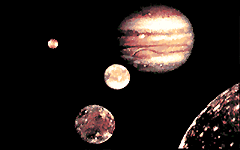 Mechanics I --- | ---
Energy
Mechanics I --- | ---
Energy

 Mechanics I --- | ---
Energy
Mechanics I --- | ---
Energy


Reading:
Chapter 1-5, P1-8 (ZG4)
 |
Key Question: | What quantities are conserved in a two-body gravitating system? |
|---|---|---|
 |
Key Principle: | Center of Mass and Momentum |
 |
Key Problem: | What is the total energy of an orbit? |
 |
Key Quote: | "To infinity, and beyond!" - B. Lightyear |
Because of Newton's third Law of reaction, if the Earth is made to orbit because of the gravitational force between the Earth and Sun, then the Sun must also orbit by the equal and opposite force. Because the forces are equal, then the accelerations are inversely proportional to the masses, and we would expect the two bodies to each orbit a point on the line between them, but closer to the more massive body (the Sun).
We will consider circular orbits as usual.
To see this, equate the centripetal forces on two masses m_1 and m_2 orbiting at distances r_1 and r_2 respectively from the orbital center:
To remain on opposite sides of the orbital center, which they must do to for force symmetry reasons, then the periods of the orbits must be the same:
and thus
Combining with the previous equation for v_1^2 / v_2^2, we get
which is the equation for the center of mass of two bodies. The relative distances from the center of mass are inversely proportional to the respective masses.
Because the mass of the Sun (2 × 10^30 kg) is so much greater than that of the Earth (6 × 10^24 kg), the center of mass of the Earth-Sun orbit lies very close to the Sun:
Since the sum of the distances r_s + r_e = 1 AU = 1.5 × 10^8 km, then r_s = 450 km, which is still very close to the center of the Sun! Q: What is the distance of the center-of-mass of the Earth-Moon system from the center of the Earth?
For two orbiting bodies, the center of mass is called the barycenter. The Sun and Earth mutually revolve around the Sun-Earth barycenter.
Because two bodies mutually revolve about their barycenter, Newton knew he had to modify Kepler's third law to take this into account. If we equate the centripetal force about the barycenter with the gravitational force between the bodies, then we find
where
is the semimajor axis of the orbit. The equation for the center of mass tells us
so
and upon substitution
and so
which is Kepler's 3rd law but now with both masses included. If we define the total mass of the system to be
then we have simply
Note that this is valid for elliptical as well as circular orbits.
We can get an easier equation by using the Earth's orbit to scale things:
Remember to use masses in units of the Sun's mass, periods in units of years, and distances in units of AU, and you can simply write:
Do not measure masses in kilograms for this equation!
 Prev Lecture ---
Prev Lecture ---
 Next Lecture ---
Next Lecture ---
 Astr11 Index ---
Astr11 Index ---
 Astr11 Home
Astr11 Home
smyers@nrao.edu Steven T. Myers